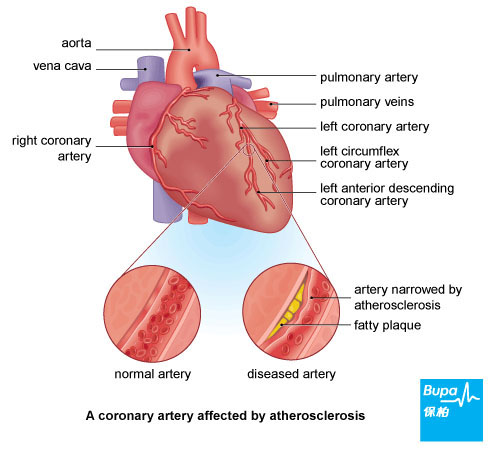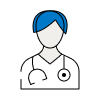Your heart is a pump that circulates blood to your lungs and the rest of your body. The surface of your heart is covered with blood vessels called coronary arteries, which supply your heart muscle with blood.
Coronary heart disease happens when fatty deposits build up on the walls of your coronary arteries. This is known as atherosclerosis.
Coronary heart disease happens when fatty deposits build up on the walls of your coronary arteries. This is known as atherosclerosis.
Atherosclerosis
In atherosclerosis, fat and cholesterol in your blood builds up on your artery walls, forming a plaque or atheroma. The plaque can prevent your heart muscle from getting the blood supply it needs. Because of the reduced blood flow and the rough edges of the plaque, a blood clot sometimes forms, blocking your artery.
Sometimes the plaque may rupture, which also causes your blood to clot. This is called atherothrombosis. Atherothrombosis stops an area of your heart muscle receiving blood and oxygen, leading to a heart attack. If a lot of your heart muscle is damaged, your heart may stop beating regularly. Sometimes the damage causes your heart to stop beating altogether, which is fatal.
Sometimes the plaque may rupture, which also causes your blood to clot. This is called atherothrombosis. Atherothrombosis stops an area of your heart muscle receiving blood and oxygen, leading to a heart attack. If a lot of your heart muscle is damaged, your heart may stop beating regularly. Sometimes the damage causes your heart to stop beating altogether, which is fatal.

Causes of coronary heart disease
Coronary heart disease is caused by the build up of fatty deposits on your artery walls.
Coronary heart disease is more common in older people. Up to the age of 65, it's more common in men than women. It's also more common among people from India and Pakistan. Factors that increase your risk of developing coronary heart disease include:
Coronary heart disease is more common in older people. Up to the age of 65, it's more common in men than women. It's also more common among people from India and Pakistan. Factors that increase your risk of developing coronary heart disease include:
- smoking
- being overweight, especially if you have excess fat around your tummy
- an inactive lifestyle
- diabetes
- high blood pressure
- high cholesterol
Symptoms of coronary heart disease
Coronary heart disease develops slowly over many years. In some people, breathlessness when exercising is the only symptom. You may not know anything is wrong until you develop angina (chest pains) or have a heart attack.
Angina
Angina is the feeling of chest pain, chest tightness, and sometimes breathlessness or choking. It happens when blood flow in the arteries that supply your heart is restricted.
Angina typically starts when you're walking or feeling upset. It can also be brought on after a meal and by cold weather. Symptoms include:
Heart attack
Most heart attacks cause severe pain in the centre of your chest and can feel like very bad indigestion. Symptoms can happen suddenly, but sometimes the pain develops more slowly. Symptoms include:
Arrhythmia
An arrhythmia is an irregular heart beat. Sometimes this can be felt as a heart palpitation (a sensation of a skipping or thumping heart beat). Sometimes palpitations are a symptom of coronary heart disease. However, heart palpitations are common, and don't necessarily mean that you have either coronary heart disease or an arrhythmia.
Heart failure
Over time, coronary heart disease may weaken your heart, leading to heart failure. Heart failure means that your heart isn't strong enough to pump blood around your body effectively and you get tired and out of breath easily. It can also lead to swelling in your ankles and legs.
Angina
Angina is the feeling of chest pain, chest tightness, and sometimes breathlessness or choking. It happens when blood flow in the arteries that supply your heart is restricted.
Angina typically starts when you're walking or feeling upset. It can also be brought on after a meal and by cold weather. Symptoms include:
- discomfort or a tightening across your upper chest - this may be confused with indigestion
- pain radiating to your neck, jaw, throat, back or arms for a few minutes, disappearing quickly after resting
- breathlessness
- sweatiness
Heart attack
Most heart attacks cause severe pain in the centre of your chest and can feel like very bad indigestion. Symptoms can happen suddenly, but sometimes the pain develops more slowly. Symptoms include:
- a feeling of heaviness, squeezing or crushing in the centre of your chest
- pain may spread to your arms, neck, jaw, face, back or stomach, lasting for hours
- loss of consciousness
- sweatiness and breathlessness
- feeling or being sick
Arrhythmia
An arrhythmia is an irregular heart beat. Sometimes this can be felt as a heart palpitation (a sensation of a skipping or thumping heart beat). Sometimes palpitations are a symptom of coronary heart disease. However, heart palpitations are common, and don't necessarily mean that you have either coronary heart disease or an arrhythmia.
Heart failure
Over time, coronary heart disease may weaken your heart, leading to heart failure. Heart failure means that your heart isn't strong enough to pump blood around your body effectively and you get tired and out of breath easily. It can also lead to swelling in your ankles and legs.
Diagnosis of coronary heart disease
Your doctor will ask about your symptoms and examine you. You will need to have some tests, which may include the following.
- Blood tests.
- Electrocardiogram (ECG) - a test that measures the electrical activity of your heart to see how well it's working. You may have an exercise ECG, which means the test is done while you're walking on a treadmill or pedalling on an exercise bike.
- Echocardiogram - a test that uses ultrasound to produce a moving 'real-time' image of the inside of your heart.
- A coronary angiogram - a test that uses an injection of a special dye into the blood vessels of your heart to make them clearly visible on X-ray images.
- Radionuclide tests - for this test your doctor will give you a small, harmless injection of radioactive material, which passes through your heart muscle. A large camera directed at your heart picks up rays sent out by the radioactive material and creates an image of your heart.
- Chest X-ray.
- MRI scan.
- Electrophysiological tests - a catheter is put into a blood vessel in your groin and guided to your heart. The tip of the catheter stimulates your heart and records the electrical activity.
Treatment of coronary heart disease
Treatment for coronary heart disease depends on how serious it is. There are several treatments available. If you have angina or have had a heart attack, angioplasty or surgery may be the best treatment option.
Medicines
Medicines aim to stop coronary heart disease getting worse or prevent further heart attacks. Some examples are listed below.
Non-surgical treatment
A coronary angioplasty involves your doctor passing a collapsed balloon through your blood vessels until it reaches the arteries of your heart. The balloon is inflated to widen your narrowed coronary artery. A stent (flexible mesh tube) is sometimes inserted to help keep your artery open afterwards.
Surgery
Your surgeon may recommend a coronary artery bypass graft (CABG). This means he or she will take a piece of a blood vessel from your leg or chest and use it to bypass the narrowed coronary arteries. The bypass provides your heart with more blood.
Medicines
Medicines aim to stop coronary heart disease getting worse or prevent further heart attacks. Some examples are listed below.
- Anti-platelet medicines such as aspirin. Taking a small (75 mg) daily dose of aspirin makes your blood less likely to form clots, reducing your risk of having a heart attack.
- Cholesterol-lowering medicines, such as statins, which slow down the process of atherosclerosis.
- Beta-blockers reduce your blood pressure and the amount of work your heart does.
- Calcium channel blockers relax and widen your arteries.
- Anticoagulants help to stop blood clots forming.
- ACE inhibitors lower your blood pressure and are often used in people with heart failure or after a heart attack.
- Nitrates relax your coronary arteries, allowing more blood to reach your heart.
- Anti-arrhythmic medicines help to control your heart rhythm.
Non-surgical treatment
A coronary angioplasty involves your doctor passing a collapsed balloon through your blood vessels until it reaches the arteries of your heart. The balloon is inflated to widen your narrowed coronary artery. A stent (flexible mesh tube) is sometimes inserted to help keep your artery open afterwards.
Surgery
Your surgeon may recommend a coronary artery bypass graft (CABG). This means he or she will take a piece of a blood vessel from your leg or chest and use it to bypass the narrowed coronary arteries. The bypass provides your heart with more blood.
Prevention of coronary heart disease
Coronary heart disease can be prevented in most people by adopting a healthy lifestyle.
You can reduce your chance of having a heart attack by:
You can reduce your chance of having a heart attack by:
- not smoking
- losing excess weight
- doing regular physical activity, for 30 minutes at least five days a week
- eating a low fat and high fibre diet with five portions of fruit and vegetables a day and two portions of fish (one oily) a week
- not exceeding four units of alcohol a day for men or three units for women. 175ml glass of wine (12%ABV) contains about 2 units.
Disclaimer
This information was published by Bupa Group's Health Content Team and has been reviewed by appropriate medical or clinical professionals. To the best of their knowledge the information is current and based on reputable sources of medical evidence, however Bupa (Asia) Limited makes no representation or warranty as to the completeness or accuracy of the Content.
The information on this page, and any information on third party websites referred to on this page, is provided as a guide only. It should not be relied upon as a substitute for professional medical advice, nor is it intended to be used for medical diagnosis or treatment. Bupa (Asia) Limited is not liable for any loss or damage you suffer arising out of the use of, or reliance on, the information.
Third party websites are not owned or controlled by Bupa and any individual may be able to access and post messages on them. Bupa is not responsible for the content or availability of these third party websites. Last updated August 2017.
The information on this page, and any information on third party websites referred to on this page, is provided as a guide only. It should not be relied upon as a substitute for professional medical advice, nor is it intended to be used for medical diagnosis or treatment. Bupa (Asia) Limited is not liable for any loss or damage you suffer arising out of the use of, or reliance on, the information.
Third party websites are not owned or controlled by Bupa and any individual may be able to access and post messages on them. Bupa is not responsible for the content or availability of these third party websites. Last updated August 2017.









